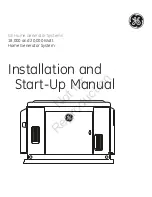
— 34 —
The other numbered Terminal Menu categories contain IP
communications settings; ‘miscellaneous’ settings relating to
date-and-time, IP password, etc.; or the entire contents of the
730 Encoder internal memory.
Typing:
??
into the Terminal window (two question marks fol-
lowed by Enter) causes the 730 Encoder to send a copy of
eve-
rything
in its memory back to the Terminal screen. Keep in
mind that this is a great deal of data and will spill off the
screen. Any single item on the list may be interrogated inde-
pendently by typing its header, a question mark and Enter.
For example, typing:
PI?
will bring up both the
hexadecimal PI value and the associated call letters
(North America only). Again, this command-set in-
formation is listed in the Appendix, beginning on
Page 76.
ENCODER HOUSEKEEPING COMMANDS
Encoder
Initialization
Typing:
INIT
is an “initialize” function, equivalent to execut-
ing the
File/Factory Defaults
command. This erases all user pro-
gramming that has been uploaded to non-volatile memory and
restores the encoder to factory-default settings.
To save an existing encoder setup, use the
READ
button on the
software screen to bring encoder settings into the software
program. Then click:
File/Save to File
to create an .rds file (see
Page 30).
Encoder Reset
Typing:
RESET
performs a ‘soft restart’ equivalent to power-
ing the encoder down and back up again. This reset command
does
not
clear the registers of any programming commands
that have been retained with a
SAVE
command.
Firmware
Version
Type:
REV
for a display of the encoder’s firmware version.
This has importance in determining whether differences exist
between 730 Encoder units purchased at different times. The
latest firmware can be downloaded from www.inovon.com.
THE SCHEDULER
The 730 Encoder includes an on-board Scheduler that can insert
dynamic PS (scrolling) messages or allow the encoder to re-
spond to other programmed commands at specified times or
intervals. This is useful when the station departs from its nor-
mal programming, either on a regular basis or for a one-time
event. For example, rather than have the title and artist infor-
mation scrolling from a playout system that’s been paused or
cut-away-from for a special event, an alternative message can
come on at the proper time and for the proper duration to
scroll during a particular scheduled program.
















































